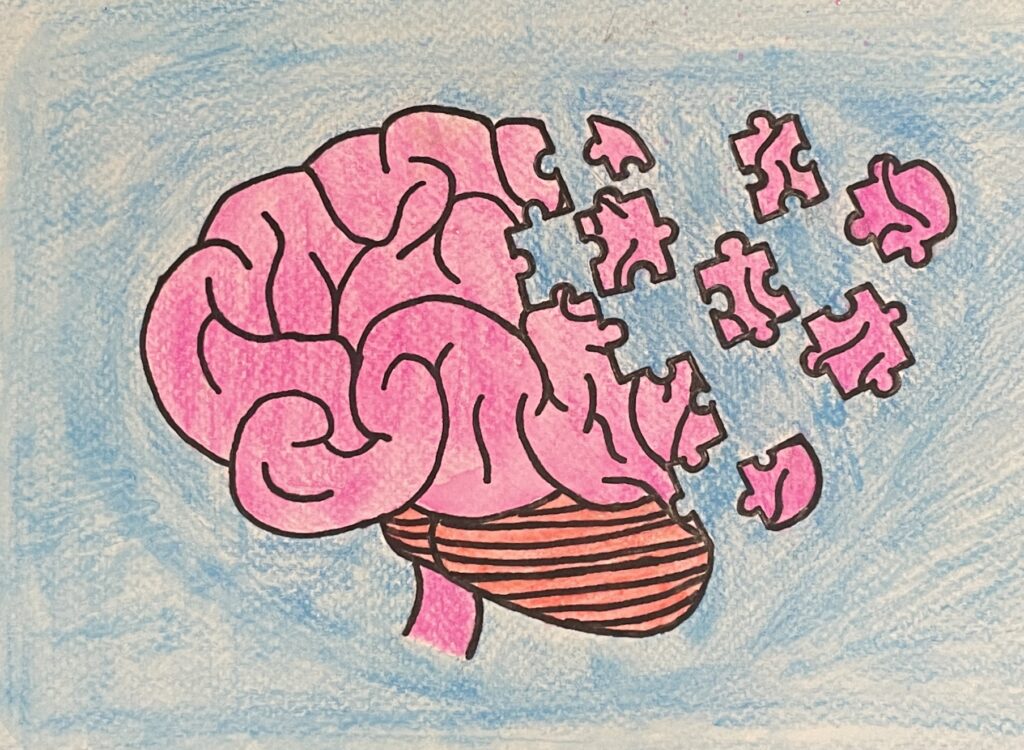
Alzheimer’s runs in my family and since I could possibly get it when I grow older I would like to learn as much as can about the disease. For this reason, I chose to cover the unit objective “explain how neurons carry an electrical charge” Alzheimer’s is very interconnected with our neurons. I’ll start by explaining how they carry an electrical charge so that we can understand how the disease destroys our brains. First, we need to understand the three different parts of a neuron there is the cell body, the dendrites, and the axon. The cell body is where the nucleus is stored and also regulates and manages the activities of the cell. The dendrites are where the neuron receives information from other neurons. The axon is a long tube-like structure that is opposite to the dendrites this is how the neuron relays information to the next neuron. These three structures enable a neuron to communicate with other neurons, which is how neurons carry an electrical charge. When a neuron receives signals from another neuron at its dendrites it generates an electrical signal that it sends down its axon. When it gets to the end of the axon this electrical signal causes the release of neurotransmitter chemicals across a tiny gap between the axon of one neuron and the dendrites of another, this gap is called a synapse. Each neurotransmitter that travels across the synapse will then bind with a specific receptor site on the other neuron’s dendrite. This then results in another chemical or electrical signal that will either stimulate or inhibit activity in the neuron. This is how neurons carry an electrical charge from one neuron to the other and this is also how our brain relays information from one part of the brain to the other.
Something to be aware of is that Alzheimer’s is a complex neurological disorder meaning that we still don’t know everything about the disease however this is some of the stuff we do know. Alzheimer’s is a well-known disorder that results in the progressive loss of memory and other neurological functions. Sadly the disease is ultimately fatal. This happens because the disease causes neurons to stop functioning, die, and lose connection to other neurons. As the disease progresses and more and more neurons die or lose function networks of neurons or the highways of our brains begin to fall apart. This ultimately leads to many regions of the brain shrinking or atrophying and by the final stages of the disease this atrophy of the brain is widespread. This all happens due to the build-up of toxic beta-amyloid, plaques, and tangles containing tau protein. The beta-amyloid is what forms the plaques due to it being chemically sticky. These plaques block synapses and cut off neuron-to-neuron communication. The tangles containing tau protein form inside the neurons, in healthy neurons these tau proteins support microtubules. However, in someone with Alzheimer’s, they break off and stick to other tau proteins inside the neuron forming the tangles. These tangles destroy a vital part of the neuron’s cell transport system which ultimately leads to cell death.
My artwork is called Alzheimer’s the disease that destroys the pieces of our brain. It depicts the brain as a puzzle and how Alzheimer’s takes apart the pieces that make our brain function. Our memories are an important part of who we are they contain both the best and the worst moments of our life but they are part of what makes us unique. Sadly Alzheimer’s destroys that part of us but hopefully, by continuing to learn more about this disease and continued research we can find a way to combat it.
References
Alzheimer’s Association. (2019). Brain Tour Part 2. Alzheimer’s Disease and Dementia; Alzheimer’s Association. https://www.alz.org/alzheimers-dementia/what-is-alzheimers/brain_tour_part_2
Graciani, A. L., Gutierre, M. U., Coppi, A. A., Arida, R. M., & Gutierre, R. C. (2023). Myelin, aging, and physical exercise. Neurobiology of Aging, 127, 70–81. https://doi.org/10.1016/j.neurobiolaging.2023.03.009
Maitre, M., Jeltsch-David, H., Okechukwu, N. G., Klein, C., Patte-Mensah, C., & Mensah-Nyagan, A.-G. (2023). Myelin in Alzheimer’s disease: culprit or bystander? Acta Neuropathologica Communications, 11(1). https://doi.org/10.1186/s40478-023-01554-5
National Institute on Aging. (2017, May 16). What Happens to the Brain in Alzheimer’s Disease? National Institute on Aging; National Institutes of Health. https://www.nia.nih.gov/health/what-happens-brain-alzheimers-disease#:~:text=In%20Alzheimer

In Kyle Banning’s STEAM project, he covers the objective of “explaining how neurons carry an electrical charge”. He did this by breaking down what makes up a neuron which is made up of three parts, the cell body, dendrites, and axons. Without these parts working together the neurons would have no way of communicating with one another. This brought Kyle to his second point of how Alzheimer’s affects our neurons and the possible effects it can have on humans. Alzheimer’s is a complex neurological disorder that is still being studied due to its complexities. It’s a progressive disease that causes memory loss and neurological dysfunctions. The neurons in a person with Alzheimer’s are disconnecting and not communicating. This leads to neurons dying causing shrinkage in the brain and atrophy. Alzheimer’s is a fatal disease once the progression of atrophy travels widely in the brain. This occurs due to the build-up of toxic beta-amyloid, plaques, and tangles containing tau protein. Beta-amyloid is what creates the plaque that blocks synapses and neuron-to-neuron communication. A neuron’s dendrites, where communication is received and relayed through the axons that are long tube-like structures. The cell body regulates and manages the activities of the cell and is also where the nucleus is stored. The artwork produced by Kyle is called, “Alzheimer’s, the disease that destroys the pieces of our brain”. It shows off the brain as if it were a puzzle, each piece being brain function. The puzzle is taking itself apart thus losing brain function. Just as Alzheimer’s does.